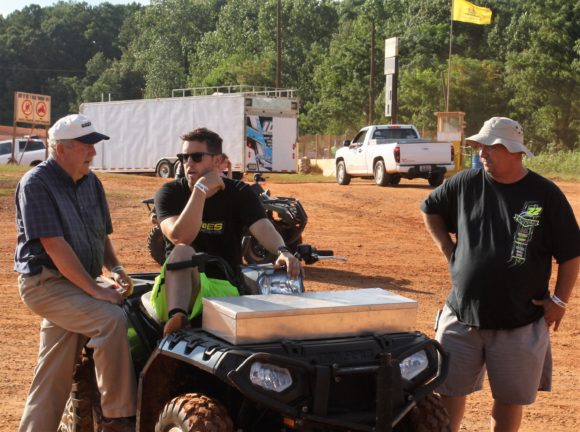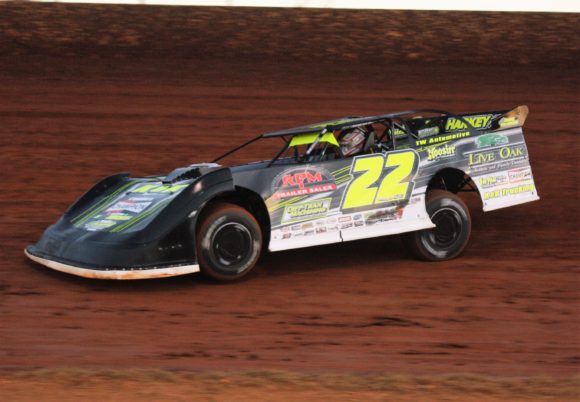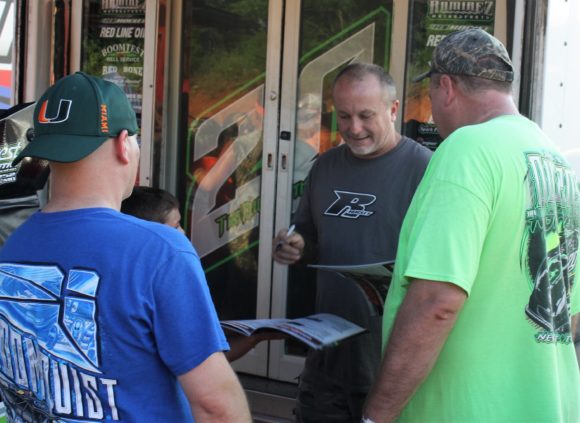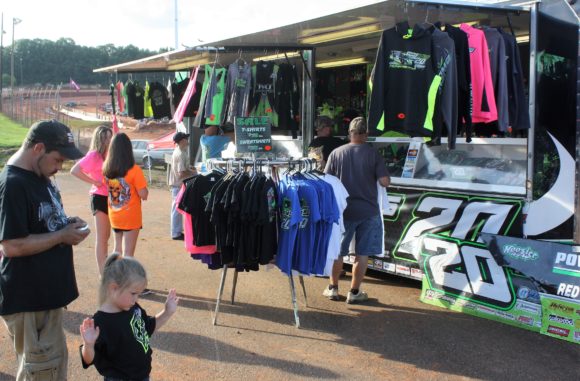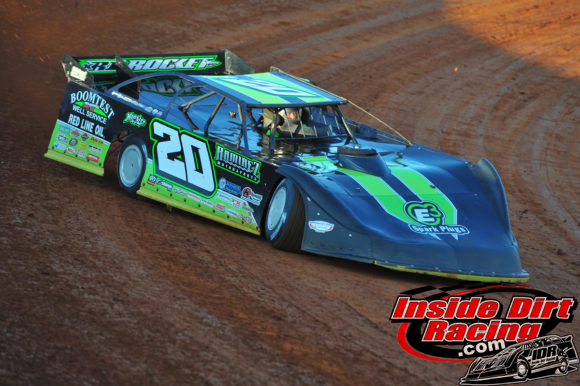In a story posted on July 5th to NBCSports.com by Nate Ryan it was stated that dirt racers have a higher earning capacity on the sales of merchandise than do NASCAR drivers. The story pointed out that drivers in NASCAR may indeed have higher gross receipts from their merchandise sales, but by the time the money is divided among the numerous entities that have staked a claim, the drivers themselves are actually making relatively little income from those sales.
At least some of Ryan’s figures came from documents pertaining to a lawsuit filed by five Dirt Late Model drivers who were barred from events sanctioned by the World Racing Group(World of Outlaws & UMP) because of tire samples that were determined to be tainted following the 2016 Dirt Late Model Dream at Eldora Speedway. The lawsuit claimed that star drivers such as Scott Bloomquist stood to lose as much as $100,000 in merchandise revenue as a result of being kept out of Eldora’s prestigious World 100.
According to two prominent dirt racers, it may very well be accurate that their revenue can exceed the diluted totals of NASCAR’s leading personalities. But unlike those who participate in NASCAR, dirt racers rely on the money made from merchandise as another means of funding their racing operations.
Chris Ferguson is one of the most popular regional Dirt Late Model drivers in the sport. The Mt. Holly, NC native has built an extensive fan base over a relatively short period of time in racing. And because of that, he and his team sell a significant number of T-shirts and other items.
“It’s definitely pretty big for us financially,” Ferguson declared in an interview with InsideDirtRacing.com. “I don’t really know a lot as far as what these other guys do because it’s just been in the last couple of years that I’ve done really good with the stuff. I hear stuff about what Scott Bloomquist, Jimmy Owens, and Jonathan Davenport sell in a year, but from what I do, it definitely makes a big difference. But here’s the thing- we’ve got so much money invested in it ourselves that people don’t realize that just because we might make 10 or 20 grand off it doesn’t mean that we didn’t put out quite a bit in the first place.”
The discussion regarding NASCAR drivers and their income from merchandise sales largely revolved around posts on Twitter by Chip Ganassi Racing driver Kyle Larson. The Sprint Car racer turned Monster Energy NASCAR Cup star was in the midst of a return to dirt racing and pointed out on social media that his income from selling merchandise at a dirt track was greater than that of his NASCAR related intake.
When asked about making appearances at his souvenir trailer on NASCAR weekends to sign items, the rising star replied, “The thing is, why should we really want to when we get such a small cut from it? An hour of our time might make us 50 dollars.”
Somewhat of a firestorm erupted on the social media network as fans responded with disdain toward the comments of a driver who seemed to be saying that it is not worth his time to meet with them and sign autographs or pose for photos.
While the more popular dirt racers do make money from souvenir sales, there are issues involved with selling merchandise. While NASCAR teams typically employ numerous crew members to build and maintain their cars, most dirt track heroes work on their own machines, which obviously places demands on their time both at the track and in their shops. Still, the racers feel an obligation to their fans in exchange for their investments.
For his part, Ferguson sees both sides of the issue. This coming on the day after he had just won his first career Lucas Oil Late Model Dirt Series feature at Fayetteville Motor Speedway in Fayetteville, NC.
“It’s a trade out and I can kind of understand where he’s(Larson) coming from because from what I understand, their percentage is so small,” the 28-year-old reasoned. “But at the end of the day, it’s kind of our duty to sign stuff for fans. Yesterday and today I’ve been stopped about every two minutes. Literally, the only thing I’ve done today is take the fan blade off the car. It can be tough at times because you don’t get the time to work on your car. I’m lucky to have a crew that allows me to do it and that may be the reason I have a lot of fans. A lot of these drivers aren’t as lucky as I am.”
Jimmy Owens is one of the most recognized Dirt Late Model drivers in the country. The three-time Lucas Oil Late Model Dirt Series champion has won just about every major race in the sport and has scores of fans as a result. His popularity is so overwhelming that it is virtually impossible to go to any dirt track in America and not see hats, shirts or bumper stickers with his name and car on them.
As a matter of fact, Owens is so widely known and his merchandise is so widely sold that his nicknames(‘The Newport Nightmare’ & ‘The O Show’) are copyright protected. And the national touring series driver is keenly aware of the importance of souvenir sales to the financial condition of his racing operation.
“We tell everybody at the trailer that when they buy shirts and stuff they are part owner of our team and that’s very true to a large extent,” Owens explained in an interview with InsideDirtRacing.com. “Without those sales it’s harder on us to race.”
Owens has a merchandise trailer that travels the series along with him. He is often seen before each race at the trailer signing items, posing for photos, and interacting with his legions of fans.
“We’ve been real fortunate with Mike and Amy Hayes to come along at the time,” the 45-year-old said. “They love doing it. We’ve always had a pretty good fan base following us so it worked out good for everybody.”
But even with all of his success and the scores of autographs he has signed, the Newport, Tenn. resident admits there are some aspects of the practice that he has never gotten used to. But at the same time, there are some things that never get old. Mostly, however, Owens believes that the relationships built with fans not only benefits him, but the sport as a whole.
“It changes your whole perspective of why I used to race,” Owens said. “I used to race because I loved it, but now there’s all kinds of people and kids. It’s awesome to know that you’re an inspiration. I never get used to signing for older people, people who are older than me. It’s great to know that you’ve impacted someone. When a kid walks up and you see it in their eyes how excited they are to see you, that changes the whole reason you race.”
On a percentage basis, NASCAR drivers may not make as much money as dirt racers from souvenir sales. But the real issues are what happens with that money once it is made and what impact has it had on the buyer. NASCAR drivers like Kyle Larson have contracts in hand that in all likelihood pay them seven-digit type salaries before the first T-shirt is ever sold. On the other hand, dirt racers often rely on the money made from their sales to continue funding their racing operations.
Further, it’s hard to make an argument that you are being deprived of money when you fly to races on private jets and stay in fancy motor homes once at the track. At the same time, when your name and likeness are being used on apparel, you ought to be getting a good cut of it.
While Larson’s point is understandable, his rationale is something that is hard to sell to fans who work hourly jobs for less than $50/hour. It is likely that the young NASCAR driver did not mean what it seemed like he meant in his tweet. However, some may very well have taken it to mean that he did not have time for them and that’s the disappointing part because the relationships between fans and drivers are perhaps more important now than they have ever been.
Chris Ferguson ultimately summed the comparison between NASCAR drivers and their revenue from merchandise sales to that of dirt racers.
“Everybody is kind of on their own deal. But I will tell you that our deal is a lot better than Kyle Larson’s. At the end of the day, I think the drivers should have the freedom to do what they want, but once they sign that agreement, that’s what they’ve got.”
To interact with us on social media, follow @RichardAllenIDR & @MichaelRMoats on Twitter or Like our Facebook page.




